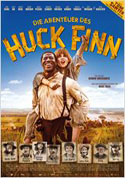

Opening 20 Dec 2012
Directed by:
Hermine Huntgeburth
Writing credits:
Sascha Arango, Mark Twain
Principal actors:
Leon Seidel, Louis Hofmann, Jacky Ido, August Diehl, Heike Makatsch
I asked director Hermine Huntgeburth why she choose to make this film, which is a typical American story, for a German audience, to which she choose to breathe smoke into my face from her cigarette and simply said she hadn’t really thought about it. I thought to myself what a strange answer. Especially when Germany is moving toward a more diverse society and acceptance of integration is an important topic. Most of us know the Mark Twain story since we had to read it in school, so it wasn’t very surprising that it, at times, had violent scenes, but much of the audience was taken aback, especially when one man dies. I think that is one of the first children’s films where I have seen a dead man floating in water. I found it also curious that most of the Caucasian characters managed to get dirty but Jim the slave remained always clean in a wonderfully white shirt. I am not sure what significance that had but somehow it seemed out of character to the original storyline. Both actors Leon Seidel and Jacky Ido, who played Jim and Huck, did a marvelous job of acting, and the scenes of the river were wild mysterious and beautiful. The film definitely was successful in creating that southern Mississippi River atmosphere, but the film ended on an off-note feeling which seemed unnatural and strange. It is also important to remember this film is not in English but in German, so for me the film was already a bit off kilter.
Nancy Tilitz adds: Leon was 16 years old playing Huck, which could have added a strangeness. Re: Jim's white shirt, which I had just accepted unthinkingly, although I agree about the impossibility of the shirt staying white. Its significance could be because Jim was Miss Watson’s house slave, more like a handyman-butler, who lived in his owner’s house and was treated as well as those times before the Civil War permitted. The incident of the slave auction where he saw his wife being auctioned showed how precarious his actual situation really was. Jim had dressed in a suit. He was shown treating his few belongings with great care. I remember when I first started working in Chicago, in the early 1970s (less than ten years after the Civil Rights Act), and would ride the subways and saw lots of black women, and was surprised at how, in comparison to white women, they seemed more styled and meticulously groomed. Am sure things have evened out in our times now. The white shirt could symbolize Jim’s pure character; he was loyal and could have saved himself from capture but chose to help his friend; or that he was an innocent victim of the society and blameless; or more negatively, it symbolized to him something he wanted to strive for, something he was not, that had power, that he hoped the whiteness would bring him. (Shelly Schoeneshoefer)